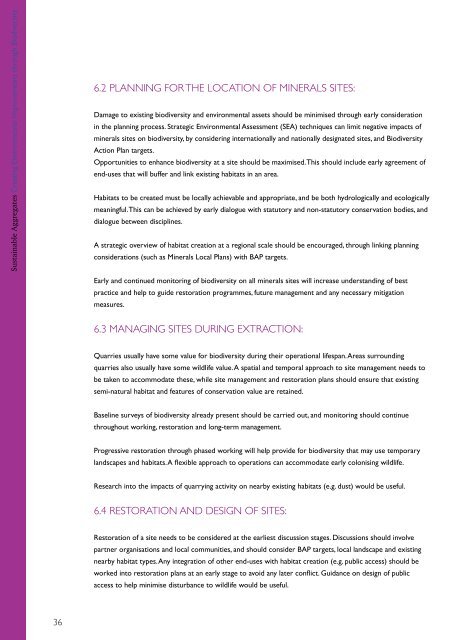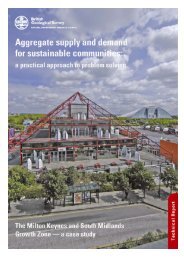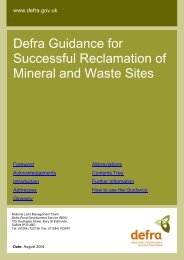creating environmental improvements through biodiversity
creating environmental improvements through biodiversity
creating environmental improvements through biodiversity
Create successful ePaper yourself
Turn your PDF publications into a flip-book with our unique Google optimized e-Paper software.
Sustainable Aggregates Creating Environmental Improvements <strong>through</strong> Biodiversity<br />
6.2 PLANNING FOR THE LOCATION OF MINERALS SITES:<br />
Damage to existing <strong>biodiversity</strong> and <strong>environmental</strong> assets should be minimised <strong>through</strong> early consideration<br />
in the planning process. Strategic Environmental Assessment (SEA) techniques can limit negative impacts of<br />
minerals sites on <strong>biodiversity</strong>, by considering internationally and nationally designated sites, and Biodiversity<br />
Action Plan targets.<br />
Opportunities to enhance <strong>biodiversity</strong> at a site should be maximised. This should include early agreement of<br />
end-uses that will buffer and link existing habitats in an area.<br />
Habitats to be created must be locally achievable and appropriate, and be both hydrologically and ecologically<br />
meaningful. This can be achieved by early dialogue with statutory and non-statutory conservation bodies, and<br />
dialogue between disciplines.<br />
A strategic overview of habitat creation at a regional scale should be encouraged, <strong>through</strong> linking planning<br />
considerations (such as Minerals Local Plans) with BAP targets.<br />
Early and continued monitoring of <strong>biodiversity</strong> on all minerals sites will increase understanding of best<br />
practice and help to guide restoration programmes, future management and any necessary mitigation<br />
measures.<br />
6.3 MANAGING SITES DURING EXTRACTION:<br />
Quarries usually have some value for <strong>biodiversity</strong> during their operational lifespan. Areas surrounding<br />
quarries also usually have some wildlife value. A spatial and temporal approach to site management needs to<br />
be taken to accommodate these, while site management and restoration plans should ensure that existing<br />
semi-natural habitat and features of conservation value are retained.<br />
Baseline surveys of <strong>biodiversity</strong> already present should be carried out, and monitoring should continue<br />
<strong>through</strong>out working, restoration and long-term management.<br />
Progressive restoration <strong>through</strong> phased working will help provide for <strong>biodiversity</strong> that may use temporary<br />
landscapes and habitats. A flexible approach to operations can accommodate early colonising wildlife.<br />
Research into the impacts of quarrying activity on nearby existing habitats (e.g. dust) would be useful.<br />
6.4 RESTORATION AND DESIGN OF SITES:<br />
Restoration of a site needs to be considered at the earliest discussion stages. Discussions should involve<br />
partner organisations and local communities, and should consider BAP targets, local landscape and existing<br />
nearby habitat types. Any integration of other end-uses with habitat creation (e.g. public access) should be<br />
worked into restoration plans at an early stage to avoid any later conflict. Guidance on design of public<br />
access to help minimise disturbance to wildlife would be useful.<br />
36

















